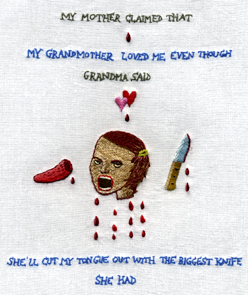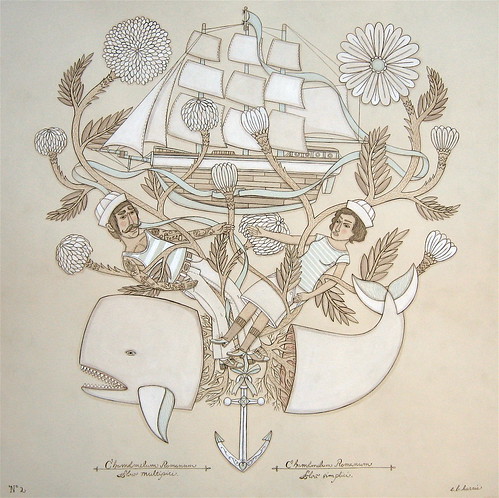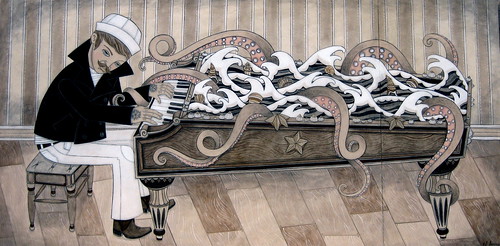- artists (39)
- career (11)
- contest (1)
- crostini (14)
- design (27)
- DIY (3)
- drupal hell (3)
- etsy (18)
- events (35)
- family (6)
- fun with google (6)
- gocco (6)
- I covet thee (13)
- Io parlo Italiano (10)
- lost and found (13)
- mc recommends (33)
- mixed media (25)
- multi-tasking (11)
- photo documentary (15)
- playing with food (5)
- projects (3)
- providence (39)
- reviews (23)
- sailing (1)
- site updates (4)
- softies (6)
- storytime (4)
- studio (21)
- the road less travelled (15)
- think green (8)
reviews, artists, Authored Articles
"SIT DOWN - THE PROCESS OF FURNITURE DESIGN" for Artscope Magazine (March/April 2008)

"Sit Down – The Process of Furniture Design"
Gallery Z
259 Atwells Ave, Providence
Show Dates: March 18th, 2008 to March 29th, 2008
<<--CLICK HERE TO VIEW THE FULL ARTICLE-->>
By Meredith Cutler (for Artscope Magazine)
The bones of well-designed furniture echo an era when everyday household articles had the artisan legacy missing from so much of today’s mass-marketed, disposable clutter. Whether your taste runs towards Eames or IKEA, furniture assumes a significant role in our human experience. Exalted as art, or taken for granted, furniture supports our weight, articulates our space and offers a strong platform for the exploration of materials, engineering and object interaction.
Fans of deliberate design and articulated process have reason to focus their lens on Providence, for the students of RISD’s renowned furniture design program are revealing the secrets behind their work in an interactive exhibit at Gallery Z, located in the neighborhood of Federal Hill. Curated by RISD senior Kallie Weinkle, “Sit Down – The Process of Furniture Design” features the diverse work of 20 emerging designers alongside the tools, visual resources and raw materials utilized throughout the creative process.
By structuring this exhibit to highlight the material narrative behind each realized furniture piece, Weinkle hopes to convey how the process of interaction between an object and an individual can be used as a communicative device, educating the user about the intentions and goals of the designer.
On a quiet Friday during RISD’s winter session, I took the opportunity to tour the workshops with Weinkle, and delve into the system churning out some of today’s most conceptual designers. The RISD curriculum typically challenges students to explore formal topics via structured assignments. However, as her first curatorial effort, Weinkle expressed a desire to steer away from any one, specific style or object and instead to offer a broad spectrum of materials, thought processes and results.
And process is what RISD emphasizes above all else. Students are encouraged to begin each piece considering function, then to realize their achievement with a balance of structure, purposeful form, and engaging material. When process is king, there is ample opportunity for deliberate choices and happy accidents to interact and form a new, physical statement.
This interaction is apparent in Alex Spain-Strombom’s leather stool, which incorporates laser-cutting technology to marry an angular, plywood structure with an unusual, geometrically patterned leather seat. As evidence of this process, burn scars were deliberately left intact, providing tonal contrast on alternating edges of the plywood supports. Up above, fine-grained, white leather takes on the surprising sheen of a woven textile, due to an optical effect caused by the irregular depth of the laser’s scar-like incisions.
Zeke Leonard offers his own, eco-conscious take on the design process. Once a set builder in New York’s entertainment industry, Leonard revolts against the rampant waste he once observed on the job by championing salvaged raw materials, otherwise destined for the landfill. His contribution to the show, a modular revision of the traditional Adirondack chair, was crafted from Douglas fir and Longleaf pine reclaimed from the floorboards of a South County Mill. This piece can be re-configured at will; either as a loveseat, or as a centered table flanked by two chairs. By reclaiming the detritus of the region’s industrial decay and transforming it into something beautiful, he hopes to encourage a de-acceleration and self-reflection not readily supported by our cultural trajectory.
An array of rich material narratives awaits the visitor, from Da Sul Kim’s draped styrene stools (molded with the heat of a pizza oven), to Annika Schmidt’s sweet, yet jarringly legless “strap-on” white chairs. If you are seeking an opportunity to sit down and smell the future of furniture, look no further. “Sit Down – The Process of Furniture Design” is on view at Gallery Z from March 18th-29th at Gallery Z.
Pictured Below: "Table" by Kallie Weinkle
Yo ho ho and a bottle of evan b. harris!
Thu, 03/13/2008 - 10:45 — adminI start my mornings with a display of crankiness, an espresso, breakfast and a peek at Design*Sponge (in that order). Well, the crankiness was dispelled more quickly than usual, thanks to Grace's post on the delightful, mixed-media work of Portland, Oregon artist Evan B. Harris. As many of you know, I have a salty spot for anything that depicts banjos, or inspires the spontaneous singing of sea-shantys...
If you are lucky enough to be in the Bay Area between today and April 2nd, make sure to visit and pay alms to his work at Rare Device!
The *NEW* new housing market (and I don't mean Mc Mansions)
Wed, 03/05/2008 - 15:04 — adminWhile the rest of us wring our hands over rising inflation, unemployment and the precipitous state of the housing market, some unshakeable folks are still contributing fresh-faced to development; namely, of domiciles, in locales and for "clients" typically overlooked once the pavers roll off the steaming lot of urban sprawl.
Los Angeles based artist and architect Fritz Haeg explores the implications of our global refacing and the potential for ecological amends in his current body of work, titled Animal Estates. Collaborating with zoological and ecological consultants on specific, art org. commissioned sites, from habitat-hammering shopping plazas to foliated, yet ecologically insensitive neighborhoods, Haeg investigates alienated local species, which he refers to as "animal clients" (e.g. New York's northern flying squirrel). Using field lab techniques, historical data and observation, he then designs and constructs dwellings condusive to welcoming that population back into the environment from which it has been dethroned due to the encroachment of human development.
As part of the 2008 Whitney Biennial, which opens tomorrow at the Whitney Museum of American Art in New York City, Haeg will be installing model homes for twelve disenfranchised native animal "clients" in front of the venerable contemporary art institution. Guided tours of the model homes will be conducted by local scientific and cultural stakeholders, such as Michael Crewdson and Margaret Mittelbach, authors of Wild New York.
If you are interested in learning more about the artist and his project for all creatures fine, furry and feathered, NPR radio show Day to Day aired a lovely interview on March 4th, which you can listen to on their website.
How will YOU spend it? (And I don't mean your rebate check...)
Fri, 02/29/2008 - 12:53 — adminHere's a calorie-burning, life-affirming, utterly wacktastic participatory arts activity to help you while away your extra day of calendarial life: Performance artist Brian Feldman is challenging you (yes, you) to contemplate how you will spend your extra 1,440 minutes on this February 29, 2008, by leaping off of a 12-foot platform in front of Orlando City Hall every 3 minutes and 56 seconds, for a total of 366 occurances during the 24 hours of leap day. Will somebody get this guy a Red Bull? (Whee!)
Extreme Embroidery
Fri, 02/22/2008 - 10:45 — adminToday the snow is falling, its treacherous Friday flakes dampening any motivation to make the snarled jaunt up Route 128 to my studio. At times like these, I like to browse my magazines and the internet for shows that I would like to attend, preferably out of town, to appeal to my "I need a change of scenery" mantra.
One that caught my eye: "Pricked: Extreme Embroidery", at the Museum of Arts & Design in New York City. Featuring edgy, contemporary takes on this ancient, embellishment craft by an international assembly of artists, both male and female. I see that the list includes Ghada Amer, whose work I have always admired. Many names are unfamiliar to me, like Andrea Dezsö, whose piece below: "My Grandmother Loved Me Even Though..." draws directly from the stitchy tradition of Sampler and floss, yet calls up a juicy undercurrent of the implications of words and interpretation in childhood.

Sounds right up my alley, actually. For a gallery of archived images of my own take on alternative embroidery, click here.












